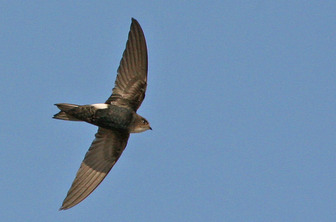Horus Swift
It also occurs very discontinuously in much of the rest of the sub-Saharan region, with the Ethiopian mountains and the area from central Kenya into Uganda having large populations. Identification difficulties confuse the limits of this species’ range.

Original source: Robert Wienand, Chloorkop, South AfricaPermission(Reusing this file)The permission for use of this work has been archived in the Wikimedia OTRS system.It is available as ticket #2009051410016422 for users with an OTRS account. If you wish to reuse this work elsewhere, please read the instructions at COM:REUSE. If you are a Commons user and wish to confirm the permission, please leave a note at the OTRS noticeboard.Ticket link: https://ticket.wikimedia.org/otrs/index.pl?Action=AgentTicketZoom&TicketNumber=2009051410016422
Author: Robert Wienand, Chloorkop, South AfricaPermission(Reusing this file)The permission for use of this work has been archived in the Wikimedia OTRS system.It is available as ticket #2009051410016422 for users with an OTRS account. If you wish to reuse this work elsewhere, please read the instructions at COM:REUSE. If you are a Commons user and wish to confirm the permission, please leave a note at the OTRS noticeboard.Ticket link: https://ticket.wikimedia.org/otrs/index.pl?Action=AgentTicketZoom&TicketNumber=2009051410016422
The Horus Swift is classified as Least Concern. Does not qualify for a more at risk category. Widespread and abundant taxa are included in this category.
Horus Swift in South Luangwa National Park, Zambia Conservation status Least Concern (IUCN 3.1) Scientific classification Kingdom: Animalia Phylum: Chordata Class: Aves Order: Apodiformes Family: Apodidae Genus: Apus Species: A. More
The Horus Swift is a Southern African bird that belongs to the apodidae bird family group which includes birds such as Typical Swifts. The description for the Horus Swift (Latin name Apus horus) can be found in the 7th Edition of the Roberts Birds of Southern Africa. The Apus horus can be quickly identified by its unique Roberts identification number of 416 and the detailed description of this bird is on page 242. More
The bulk of the Horus swift's population is in southern Africa, mainly in South Africa and Zimbabwe but strangely absent from Botswana. It usually forages in flocks over open areas, feeding on a wide range of insects. It is a monogamous, colonial nester, often living in mixed-species colonies of about 2-10 breeding pairs. It usually takes control of old tunnels excavated by other birds, building a small pad out of diverse materials glued together with saliva, which it places in the chamber at the tunnel's end. More
horus swift Kruger National Park birds The Horus Swift (Latin name Apus horus) is described in Roberts Birds of Southern Africa, 7th Edition. This bird has a unique Roberts number of 416 and you will find a full description of this bird on page 242 also a picture of the Horus Swift on page 257. The Horus Swift belongs to the family of birds classified as apodidae. The map of the Kruger you see on this page shows the areas (coloured orange) where this bird has been identified. More
Horus Swift in Arusha National Park, 22 January 2006. Photo Martin Goodey. More
The Horus Swift, Apus horus, is a small bird in the swift family. It breeds in sub-Saharan Africa. It has an extensive continuous distribution from eastern and southern South Africa north to southern Zambia and central Mozambique, and has recently colonised the De Hoop Nature Reserve area of the Western Cape. More
Horus Swifts breed in sand banks and cliffs, hence why they are supposed to be common at Marievale as they nest in the mine dumps there. I eventually saw some there, having found them in Zimbabwe in February 2008 and then at Leeuwpan near Leandra for my first SA record. They have a noticeably shallower fork in their tail than White-rumped. More
Horus Swift in Arusha National Park, 22 January 2006. Photo Martin Goodey. Arusha | Birds | Horus Swift» thumbnail | full | big_thumbnail | printer friendly version bhlqblRmSZZinOVABt Submitted by zusecon on Sat, 2010-05-15 05:56. qn8rS1 acomplia dgkdee prednisone blfers valium >:(( valium =P accutane zglhfg » reply clGQdegKYrwszWaShZl Submitted by chattan on Fri, 2010-04-16 22:48. More
The Horus Swift, Apus horus, is a small bird in the swift family. Horus Heresy In the fictional Warhammer 40,000 universe, the Horus Heresy was a galaxy-spanning civil war that marked the end of the Great Crusade. Mythology of Stargate In the fictional universe of the Stargate franchise, the people of Earth have encountered numerous extraterrestrial races on their travels through the Stargate. More
Results for: Horus SwiftTranslations 1 - 1 of 1 English English Norwegian Norwegian swift hurtig Search time: 0.151 sec. About EUdict - EUdict (European dictionary) is a collection of online dictionaries for the languages spoken in the European Community and the countries that will become members of European Community. More
Apus horus is commonly known (its common name) as the Horus Swift in English. Apus horus is classified as least concern by the IUCN Red List of Threatened Species, the world's most comprehensive inventory of the global conservation status of plant and animal species maintained by the International Union for Conservation of Nature and Natural Resources. Species Authority: The species authority, or the name(s) of scientist(s) or person(s) who first described Apus horus is (Heuglin, 1869) (IUCN Red List). More
The Horus swift (Apus horus) usurps burrows of bee-eaters and othe burrowing birds while two other African species, the white-rumped swift (Apus caffer) and Bates's swift (Apus batesi) utilize old swallow nests that they reline with feathers. The most elaborate structures are the tubular nests of the swallow-tailed swifts (Panyptila) of Central and South America, which are made of plant seed floss glued together with salivary cement into a felt-like material. More

